

The Resilience Project. @seni_bl useful for growth mindset in the classroom #aussieED. Developing a growth mindset. I’ve decided to use the spring break as an opportunity to catch up on some long overdue reading – starting with ‘Mindset’ by Carol Dweck.
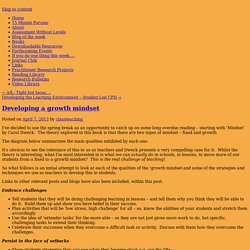
The theory explored in this book is that there are two types of mindset – fixed and growth. The diagram below summarises the main qualities exhibited by each one: 6 Strategies For Teaching the Growth Mindset. Albert Einstein is considered one of the greatest geniuses of all time, though rumor has it he failed high school calculus.
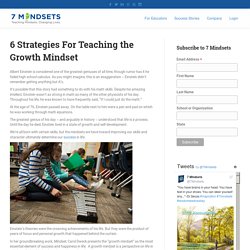
As you might imagine, this is an exaggeration ‒ Einstein didn’t remember getting anything but A’s. It’s possible that this story had something to do with his math skills. Despite his amazing intellect, Einstein wasn’t as strong in math as many of the other physicists of his day. Throughout his life, he was known to have frequently said, “If I could just do the math.” At the age of 76, Einstein passed away. The greatest genius of his day ‒ and arguably in history ‒ understood that life is a process. Response: Classroom Strategies to Foster a Growth Mindset. Teaching strategies to create 'growth' mindsets. Research has busted the myth that intelligence is fixed and cannot be changed and has put forward a new approach – the growth mindset.
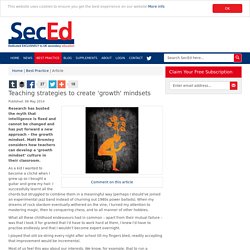
Matt Bromley considers how teachers can develop a ‘growth mindset’ culture in their classroom. As a kid I wanted to become a cliché when I grew up so I bought a guitar and grew my hair. I successfully learnt all the chords but struggled to combine them in a meaningful way (perhaps I should’ve joined an experimental jazz band instead of churning out 1980s power ballads). When my dreams of rock stardom eventually withered on the vine, I turned my attention to mastering magic, then to conquering chess, and to all manner of other hobbies. Growth Mindset in my Primary Classroom. Since September, I've been introducing my primary (year 4) class to the idea of how a growth mindset can help with learning.
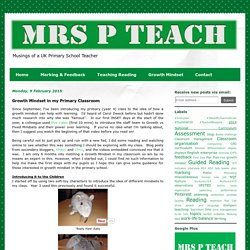
I'd heard of Carol Dweck before but hadn't done much research into why she was "famous". In our first INSET days at the start of the year, a colleague used this video (first 10 mins) to introduce the staff team to Growth vs Fixed Mindsets and their power over learning. If you've no idea what I'm talking about, then I suggest you watch the beginning of that video before you read on! Being careful not to just pick up and run with a new fad, I did some reading and watching online to see whether this was something I should be exploring with my class.
Blog posts from secondary bloggers, Shaun and Chris, and the videos embedded convinced me that it was. Introducing it to the Children. How to make growth-mindset theory work in the classroom. “When I read the book Mindset by Carol Dweck, I kept turning the page hoping that she might start to tell me how to ‘do it’ in the classroom,” says Katie Walton, a teacher from Cambridgeshire.
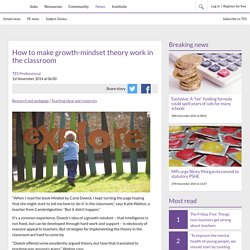
“But it didn’t happen.” It’s a common experience. Dweck’s idea of a growth mindset – that intelligence is not fixed, but can be developed through hard work and support – is obviously of massive appeal to teachers. But strategies for implementing the theory in the classroom are hard to come by. “Dweck offered some excellently argued theory, but how that translated to teaching was anyone’s guess,” Walton says. Writing in the 31 October issue of TES, she explains that with nothing to go on, she developed some strategies of her own. Teaching strategies to create 'growth' mindsets. Becoming a growth mindset school. The idea of becoming a growth mindset school has been over a year in the making.
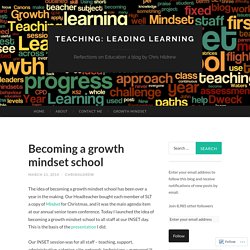
Our Headteacher bought each member of SLT a copy of Mindset for Christmas, and it was the main agenda item at our annual senior team conference. Growth Mindset Activities, Growth Mindset and Growth Mindset Lessons. Developing a Growth Mindset in Teachers and Staff. The New Psychology of Success (2000), Dweck developed a continuum upon which people can be placed, based upon their understandings about where ability comes from.
For some people (at one end of said continuum), success (and failure) is based on innate ability (or the lack of it). Deck describes this as a fixed theory of intelligence, and argues that this gives rise to a ‘fixed mindset’. At the other end of the continuum are those people who believe success is based on a growth mindset. These individuals argue that success is based on learning, persistence and hard work. Top Ten Tips for developing a Growth Mindset in your Classroom. Be Critical.

Students should expect and welcome criticism. They must also be given the opportunity to act on any criticism or critique. Mindset Works®: Student Motivation through a Growth Mindset, by Carol Dweck, Ph.D. Research on the growth mindset shows that students who believe they can grow their basic abilities have greater motivation and higher achievement than do students who believe their abilities are fixed, and that teachers can influence students’ mindsets.
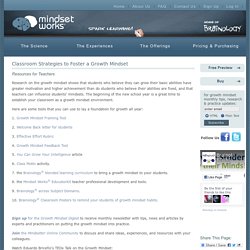
The beginning of the new school year is a great time to establish your classroom as a growth mindset environment. Here are some tools that you can use to lay a foundation for growth all year: 1. Edsurge. Contrary to popular belief, high achievement isn’t merely a product of talent and ability. In fact, our internal beliefs about our own abilities, skills, and potential actually fuel behavioral patterns and predict success. Leading Stanford psychologist Carol Dweck argues that the pivotal quality separating successful people from their unsuccessful counterparts is whether they think their intelligence can be developed versus believing it is fixed. “There is no relation between students' abilities or intelligence and the development of mastery-oriented qualities. Some of the very brightest students avoid challenges, dislike effort, and wilt in the face of difficulty. And some of the less bright students are real go-getters, thriving on challenge, persisting intensely when things get difficult, and accomplishing more than you expected.
This is something that really intrigued me from the beginning. Edsurge. Honda the Power of Dreams Failure: The Secret to Success. Audri's Rube Goldberg Monster Trap. You Don't Know Jack - Morgan Spurlock - GE FOCUS FORWARD. Famous Failures. The Roses of Success. What if the Secret to Success Is Failure? Over the course of the next year and a half, Duckworth worked with Levin and Randolph to turn the list of seven strengths into a two-page evaluation, a questionnaire that could be completed by teachers or parents, or by students themselves.

For each strength, teachers suggested a variety of “indicators,” much like the questions Duckworth asked people to respond to on her grit questionnaire, and she road-tested several dozen of them at Riverdale and KIPP. She eventually settled on the 24 most statistically reliable ones, from “This student is eager to explore new things” (an indicator of curiosity) to “This student believes that effort will improve his or her future” (optimism). For Levin, the next step was clear. Wouldn’t it be cool, he mused, if each student graduated from school with not only a G.P.A. but also a C.P.A., for character-point average? Photo Back at Riverdale, though, the idea of a character report card made Randolph nervous. Video Continue reading the main story. Glogin?URI= Making Friends With Failure. No one likes failure, the F-word, no matter how you sugarcoat it.
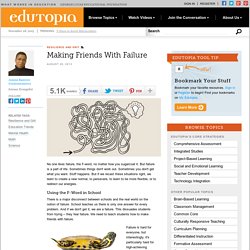
But failure is a part of life. Sometimes things don't work out. Sometimes you don't get what you want. Stuff happens. But if we recast these situations right, we learn to create a new normal, to persevere, to learn to be more flexible, or to redirect our energies. Using the F-Word in School There is a major disconnect between schools and the real world on the notion of failure. Failure is hard for everyone, but interestingly, it's particularly hard for high-achieving students. How to Help Kids Overcome Fear of Failure. A couple of weeks ago, a New York Times op-ed asked the question, “Are kids too coddled?” In other words, shouldn’t we let them fail once in awhile so they develop some backbone? Or don’t they just need more grit? The answer is not that simple because human beings are not that simple. According to UC Berkeley professor Martin Covington, the fear of failure is directly linked to your self-worth, or the belief that you are valuable as a person.
As a result, Covington found that students will put themselves through unbelievable psychological machinations in order to avoid failure and maintain the sense that they are worthy—which, as all of us who have ever dealt with the fear of failure know, can have long-term consequences. 9 Ways To Help Students Learn Through Their Mistakes. 9 Ways To Help Students Learn Through Mistakes by bettermarks.com Ed note: This post is promoted by bettermarks, a company looking for teachers to beta test their adaptive Math software. They contacted us and asked how they could get in touch with teachers to use their platform and give them feedback. They also wanted to share some thinking on the idea of mistakes in the learning process, an idea their platform is built on. The result of both goals is the post below.